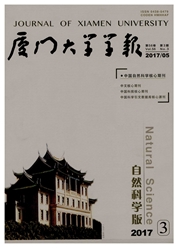

 中文摘要:
中文摘要:
设计合成了化学传感分子2,2’-二乙酰色氨酸甲酯(bATM),应用吸收光谱考察了其对金属离子(Cu2+,Hg2+,Pb2+,Zn2+,Cd2+和Ni2+)的响应.结果表明,bATM的吸收光谱仅对Cu2+响应显著,光谱红移102nm,溶液由无色转变为黄色,实现了Cu2+的高选择性高灵敏裸眼识别.对Cu2+的响应线性范围为5.0×10-8~1.8×10-5 mol/L,检测限为5.5nmol/L.初步探讨了传感分子与Cu2+的结合模式和光谱传感机制.
 英文摘要:
英文摘要:
A 2,2′-bistryptophan derivative(bATM) was designed as a selective and sensitive chemosensor for Cu2+among heavy metal ions(Cu2+,Hg2+,Pb2+,Zn2+,Cd2+ and Ni2+) in acetonitrile and water-acetonitrile binary solvents.Absorption spectrum of bATM in acetonitrile peaked at 320 nm was found to exhibit a huge red-shift to 420 nm in the presence of Cu2+,together with the appearance of two isosbestic points at 270 nm and 350 nm.In water-acetonitrile binary solvents however the absorption spectral evolution becomes weaker and the spectral variation is less with increasing water content,suggesting that the hydration of Cu2+plays a role.The red-shift in water-acetonitrile binary solvents was found to be smaller too,now from 314 nm to 360 nm,despite the observation of two isosbestic points.In acetonitrile the absorbance of bATM at 420 nm is linear to Cu2+concentration over 5.0×10-8 mol/L to 1.8×10-5 mol/L,with a detection limit of 5.5 nmol/L(3σ/k).Job plot indicates that bATM coordinates with Cu2+in a 2∶1 stoichiometry.CD spectral titrations in acetonitrile suggest a conformation change in bATM upon coordinating Cu2+that it takes a cis-conformation in terms of its two tryptophan moieties and becomes more planar in the Cu2+-complex.Although detailed sensing mechanism remains to be clarified,the observed high sensitivity and selectivity of bATM in its absorption spectral response toward Cu2+suggests that the structural framework of bATM deserves further effort for developing sophisticated chemosensors for transition metal ions,for example by modifying its structure in the amino acid moiety.
 同期刊论文项目
同期刊论文项目
 同项目期刊论文
同项目期刊论文
 Supramolecular aggregation/disaggregation-based molecular sensing: a review focused on investigation
Supramolecular aggregation/disaggregation-based molecular sensing: a review focused on investigation Anion Binding of N-(o-Methoxybenzamido)thioureas: Contribution of the Intramolecular Hydrogen Bond i
Anion Binding of N-(o-Methoxybenzamido)thioureas: Contribution of the Intramolecular Hydrogen Bond i Ratiometric Fluorescent Chemosensor for Hg2+ Based on Heptamethine Cyanine Containing a Thymine Moie
Ratiometric Fluorescent Chemosensor for Hg2+ Based on Heptamethine Cyanine Containing a Thymine Moie Enhanced saccharide sensing based on simple phenylboronic acid receptor by coupling to Suzuki homoco
Enhanced saccharide sensing based on simple phenylboronic acid receptor by coupling to Suzuki homoco A facile and general approach for the synthesis of fluorescent silica nanoparticles doped with inert
A facile and general approach for the synthesis of fluorescent silica nanoparticles doped with inert Metal-Metal-Interaction-Facilitated Coordination Polymer as a Sensing Ensemble: A Case Study for Cys
Metal-Metal-Interaction-Facilitated Coordination Polymer as a Sensing Ensemble: A Case Study for Cys Ultrasensitive Pb(2+) detection based on fluorescence resonance energy transfer (FRET) between quant
Ultrasensitive Pb(2+) detection based on fluorescence resonance energy transfer (FRET) between quant Fluorescent sensing of anions based on excited state intramolecular proton transfer in N-(3-hydroxy-
Fluorescent sensing of anions based on excited state intramolecular proton transfer in N-(3-hydroxy- Sensing hydrogen peroxide involving intramolecular charge transfer pathway: A boronate-functioned st
Sensing hydrogen peroxide involving intramolecular charge transfer pathway: A boronate-functioned st Ring Expansion of Spiro-thiolactam in Rhodamine Scaffold: Switching the Recognition Preference by Ad
Ring Expansion of Spiro-thiolactam in Rhodamine Scaffold: Switching the Recognition Preference by Ad A highly sensitive and selective antioxidant probe based on a bi-modally functionalized conjugated p
A highly sensitive and selective antioxidant probe based on a bi-modally functionalized conjugated p Ultrasensitive detection of phenolic compounds based on a spin-labeled luminescent lanthanide comple
Ultrasensitive detection of phenolic compounds based on a spin-labeled luminescent lanthanide comple 期刊信息
期刊信息
